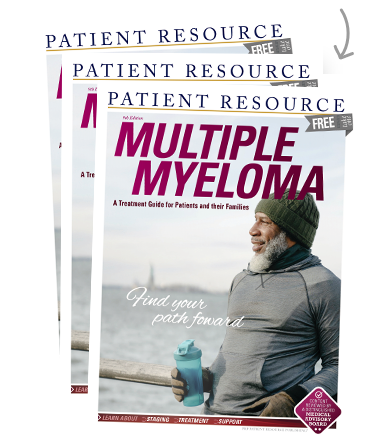Multiple Myeloma
Genomic Testing & Biomarkers
Genomic testing sounds complicated — and it is. But the good news is that you do not have to understand it completely. Simply knowing that it may offer you more options is an excellent foundation for talking with a specialist about the testing and how the results may fit into your treatment plan.
This type of testing, which is also referred to as molecular testing, is integral to precision medicine. It is an approach which allows doctors to prevent, diagnose, stage and treat some patients according to the unique characteristics of their cancer.
During the diagnostic process, genomic testing is performed on the tumor, a blood sample or a bone marrow sample to look specifically for changes in chromosomes, genes, proteins and other factors that may indicate the aggressiveness of the disease (see Table 1).
Ideally, this testing is performed before treatment begins. However, it can be performed at any time during treatment or if there is a recurrence. When a tumor returns, it may have different mutations than before, which may affect treatment options.
The Basics
Cancer is ultimately a disease of our genes, which are pieces of DNA — the information plan for the growth and control of our cells. Cancer forms when genes begin to mutate (change) within the structure of normal cells. Just as every person has a specific and unique blend of genes, cancers are driven by a mixture of specific mutations. Genomic testing is built on finding those mutations in the DNA of a cell.
Several types of chromosome mutations can lead to cancer:
- Deletion — Part of the chromosome is missing or deleted.
- Duplication — Part of the chromosome is duplicated, resulting in extra genetic material.
- Inversion — Part of the chromosome has broken off, turned upside down and reattached.
- Rearrangement — Part of the chromosome has broken off and reattached, creating a different order of its genes, which may create a new gene.
- Rings — Part of the chromosome has broken off and formed a circle or ring.
- Translocation — Part of the chromosome is transferred to another chromosome.
If your test results indicate you have one or more chromosome mutations, ask your doctor to share the specific results. Knowing the details of your diagnosis will help you to understand the aggressiveness of the disease and be more confident regarding your decisions about your treatment options.
Following are some of the chromosome mutations that may indicate high-risk multiple myeloma:
- Deletion of part or all of chromosome 17
- Deletion of part or all of chromosome 13
- Translocation of part of chromosome 4 with part of chromosome 14
- Translocation between parts of chromosomes 14 and 16
- Translocation between parts of chromosomes 14 and 20
- Duplication/amplification or deletion of part of chromosome 1
Research and clinical trial studies are ongoing to identify new chromosome mutations and, in turn, to develop therapies to treat them.
As you and your doctor discuss your genomic testing results, discuss whether you should consider participating in a clinical trial.
Table 1. What the Test Does
| Test | Purpose |
| Cytogenetics | Evaluates cells for chromosome abnormalities by looking for genetic changes at the DNA level in a bone marrow sample. Abnormalities, such as chromosomes that are broken, rearranged or missing, may indicate the level of disease. Cytogenetic analysis may help your doctor determine the treatment plan most likely to be effective for you. |
| Fluorescence in situ hybridization (FISH) | Detects abnormal cells that may be associated with a more advanced myeloma. During the test, fluorescent dye is used to highlight genes or areas of chromosomes under a microscope to look for abnormalities that might have clinical implications. |
| Measurable/minimum residual disease (MRD) | Determines the number of cancer cells that are present in bone marrow. “MRD positive” means disease is still detected. “MRD negative” means no disease is detected. |
| Biomarker Testing | Detects biomarkers, which are substances that can be measured in the blood, plasma, urine, cerebrospinal fluid or other body fluids or tissues. Biomarkers that are commonly tested for in multiple myeloma include albumin, beta-2-microglobulin and lactate dehydrogenase. |
| Flow Cytometry | Measures the number of cells, the percentage of live cells and certain characteristics of cells, such as size and shape in a sample of blood or bone marrow. The presence of tumor markers/biomarkers, such as antigens, on the surface of cells is also measured. This aids in diagnosis. |
| Immunohistochemistry | Uses antibodies to check for certain antigens in a sample of tissue. May be used to help with diagnosis and to determine the difference between certain types of cancer. |



